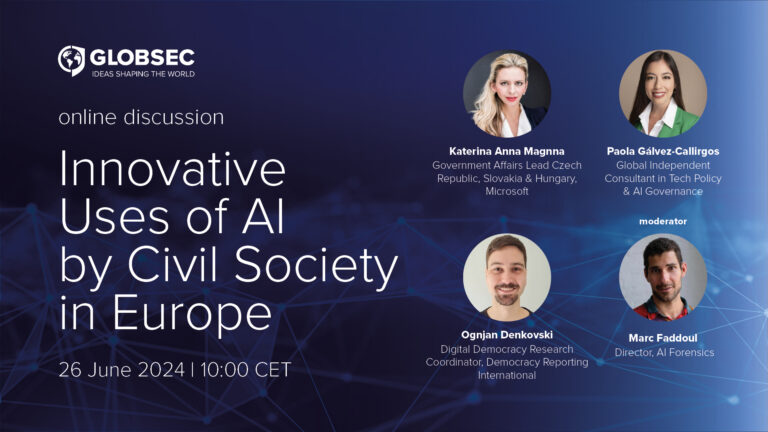On June 26th, GLOBSEC hosted an online discussion to highlight innovative uses of AI by European civil society organizations, explore tools and technologies from leading tech companies designed to support these efforts, and address ethical challenges and concerns related to AI in civil society. If you missed it or would like a refresher, read the event summary below. The summary includes a summary and a list of the specific AI tools that were discussed.
The session began with moderator Marc Faddoul from AI Forensics emphasizing the ubiquitous role that AI plays in both the personal and professional spheres. He noted that we need to consider not only the misuse of AI for disinformation and other harmful activities, but also its potential to aid individuals and organizations.
Caterina Anna Magna of Microsoft introduced the latest AI tools and platforms developed by Microsoft to support civil society efforts. She emphasized the importance of mastering these tools to increase efficiency, noting that tasks that once took an hour can now be completed in seconds with AI. She said the technology is beneficial to organizations of all sizes, allowing them to automate routine tasks, generate actionable insights from data, streamline decision-making, engage with stakeholders more effectively, and strengthen security measures.
Microsoft also recognizes the resource constraints faced by NGOs, especially those with limited budgets and manpower. To address this, the company has rolled out a series of trainings, tools, and hubs to help NGOs effectively leverage AI, all of which are detailed below. Caterina also mentioned that Microsoft has set special rates for NGOs, offering discounts on prices and licenses. She also said that NGOs can contact Microsoft directly through the “Nonprofit Community” or Philanthropy team if they have any questions or suggestions.
Ognjan Denkovski from Democracy Reporting International (DRI) shared how DRI is applying AI to its work, providing practical examples that other civil society organizations can replicate. He discussed the use of AI tools for topic modeling, analysis of online content for toxicity, machine translation, and early detection of techniques that may be used for disinformation, all of which are explained in further detail in the list below.
Ogunyan also looked at DRI’s monitoring of the recent European Parliament elections, applying topic modelling and toxicity analysis across eight countries to generate an overall toxicity score. The findings, published online, highlight the prevalence of harmful language in the discourse.
He also mentioned a relatively recent project, Disinfo Radar, which uses in-house developed AI tools to provide early assessments of the potential impact of emerging technology tools on disinformation. The developed toolset automates data collection and analysis from electronic preprint repositories (arXiv), industry papers (syncedreview.com) and policy publications (IEEE), creates clusters of technology-related topics and calculates a disinformation potential score based on mentions in the dataset.
Paola Gálvez Callirgos, an independent global consultant in technology policy and AI governance, shared insights on how AI tools can be used to enhance CSO operations. She outlined strategies for using AI to enhance fundraising efforts, boost creativity, clearly communicate program impact, and strengthen community connections.
Paola highlighted a key problem in fundraising: its highly transactional nature, which often discourages repeat giving. This leads to a reactionary approach in CSO operations, where the urgency of communication increases burnout rates among development staff and leaves donor retention low. This dynamic is damaging to the sector, Paola noted. However, she highlighted that AI has great potential to revolutionize fundraising, creating more meaningful interactions for all stakeholders involved and ensuring the sustainability of the relationships that organizations value most. Tools like Fundraising.ai are crucial, allowing them to predict who is likely to donate within the next 12 months and identify donors who may not be a good fit for contact.
Paola also pointed out the key role played by data and the ability to analyze it quickly: many NGOs lack dedicated data analysts, making AI that allows organizations to create summaries and analyses a valuable asset.
A list of useful AI tools mentioned during the discussion:
Digital Skills Resource Hub – Resources for AI, cyber security, green skills and learning materials.
TechSoup: Microsoft Digital Skills Center for Nonprofits – Webinars, recordings, guides, and best practices on Microsoft AI tools.
Certifications and learning paths from LinkedIn Learning – Courses on AI, cybersecurity, and other digital skills.
DemoDays: Microsoft Tools and Technologies for Nonprofits – Live and recorded webinars on Microsoft AI tools.
LinkedIn Nonprofit Resource Hub – Guides and best practices for maximizing LinkedIn’s potential.
AI Explained – Resources for learning the basics of generative AI.
TechSoup: Explore AI with Microsoft tools – Discounted learning paths for nonprofits.
Nonprofit Community – Discussion forums dedicated to nonprofits, providing best practices, events, and networking opportunities.
AI Trainer Toolkit – A toolkit for trainers to equip others with AI skills.
AI Learning Hub – Training resources tailored to specialized roles and specific technologies.
AI for Educators – Resources for understanding the fundamentals of generative AI.
AI Compass for Nonprofits – A tool to measure an organization’s digital maturity.
Nonprofit training and resources – self-paced, on-demand training on Microsoft solutions.
BERTopic – A topic modeling tool that integrates with OpenAI and Langchain to generate topic representations.
Perspective API – Part of Google’s Jigsaw initiative, this tool performs toxicity analysis in about 20 languages.
OPUS MT model – A machine translation tool based on the Transformer architecture. Useful for many language pairs, but relatively slow.
Fundraising.ai – Predicts potential donors likely to give within the next year and identifies donors NGOs should avoid contacting.


